223. Redgrave, J., and Wright, D. Jan. 18.
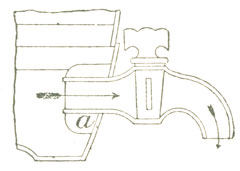 Moulding. — In making moulded glass vessels or other hollow articles, in which holes are required for the insertion of taps, stoppers, or other attachments, such holes are left in the article at the time they are moulded, and an increased thickness a is formed round the holes in the interior of the article. The inner ends of the holes may be closed by a thickness of glass when moulded, which can be readily removed afterwards to complete the hole. The holes may be formed with screw-threads to receive screw attachments. The invention may be applied to glass barrels, filters, lamp and other vases, ink holders with two or more compartments, jugs, tankards, cups, hollow globes for forming ornaments, chandelier and lamp bodies, knife, door, tea-kettle, beer-machine, and other handles, and other hollow glass vessels or fittings. Glass taps, pipes, or stoppers may be formed in a like manner for the insertion of a plug of glass or other material with or without washers. Moulding. — In making moulded glass vessels or other hollow articles, in which holes are required for the insertion of taps, stoppers, or other attachments, such holes are left in the article at the time they are moulded, and an increased thickness a is formed round the holes in the interior of the article. The inner ends of the holes may be closed by a thickness of glass when moulded, which can be readily removed afterwards to complete the hole. The holes may be formed with screw-threads to receive screw attachments. The invention may be applied to glass barrels, filters, lamp and other vases, ink holders with two or more compartments, jugs, tankards, cups, hollow globes for forming ornaments, chandelier and lamp bodies, knife, door, tea-kettle, beer-machine, and other handles, and other hollow glass vessels or fittings. Glass taps, pipes, or stoppers may be formed in a like manner for the insertion of a plug of glass or other material with or without washers.
|
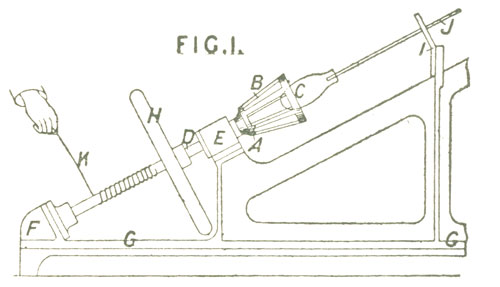
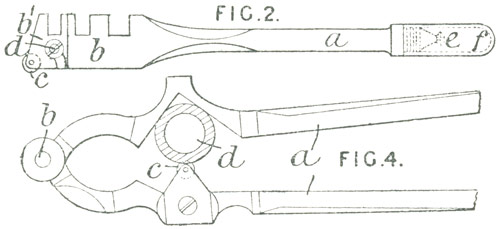

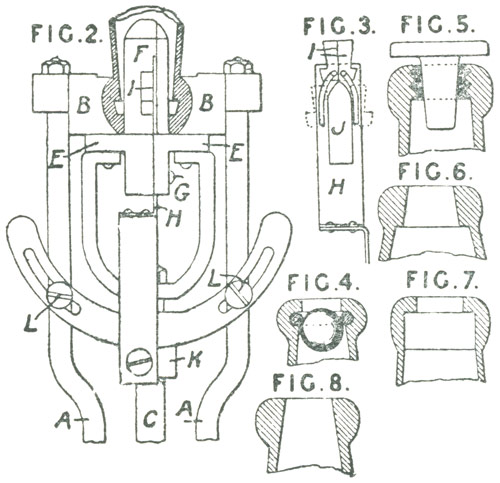



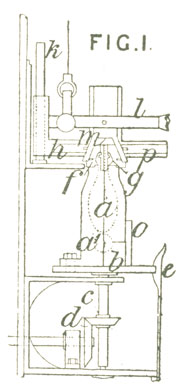 Blowing and moulding bottles. — Relates to apparatus for forming the ring upon the top of the neck, before removing the bottle from the mould. The mould a is formed in two parts hinged at a1, one part being secured to a table b mounted on a vertical axis c, which can be rotated by bevel friction gearing d when a catch e is released. A spring stop o keeps the mould closed. The neck is formed in a mould made in two parts f, g, each capable of sliding along an arm h, mounted on a boss which can rotate, and also slide vertically on an axis k. Jointed to this boss is an arm l carrying projections m, which pass between pins on the parts f, g. By raising or lowering the arm l the parts f and g approach or recede from each other. When the neck is to be formed the blowpipe is nearly withdrawn from the mould a, the parts m are turned aside, the neck mould f, g is lowered, and the catch e is released to allow the mould a to rotate and draw in molten glass from the end of the rod applied by the workman to form the neck. The mould which shapes the head is held clear of the bottle when not in use, by means of a cord. In a modification, the mould is mounted on a horizontal axis, but can be turned into a vertical position while the bottle is being blown. The neck mould is carried by a horizontal slide. The mould may form a groove around the interior of the head, but when making bottles without a groove the head mould may be formed like the tongs generally used for shaping the bottle head. The apparatus is specially applicable to making large-necked bottles such as pickle jars, acid bottles, &c. According to the Provisional Specification, instruments for shaping any part of the interior of the bottle may be introduced through the neck before shaping or moulding the head.
Blowing and moulding bottles. — Relates to apparatus for forming the ring upon the top of the neck, before removing the bottle from the mould. The mould a is formed in two parts hinged at a1, one part being secured to a table b mounted on a vertical axis c, which can be rotated by bevel friction gearing d when a catch e is released. A spring stop o keeps the mould closed. The neck is formed in a mould made in two parts f, g, each capable of sliding along an arm h, mounted on a boss which can rotate, and also slide vertically on an axis k. Jointed to this boss is an arm l carrying projections m, which pass between pins on the parts f, g. By raising or lowering the arm l the parts f and g approach or recede from each other. When the neck is to be formed the blowpipe is nearly withdrawn from the mould a, the parts m are turned aside, the neck mould f, g is lowered, and the catch e is released to allow the mould a to rotate and draw in molten glass from the end of the rod applied by the workman to form the neck. The mould which shapes the head is held clear of the bottle when not in use, by means of a cord. In a modification, the mould is mounted on a horizontal axis, but can be turned into a vertical position while the bottle is being blown. The neck mould is carried by a horizontal slide. The mould may form a groove around the interior of the head, but when making bottles without a groove the head mould may be formed like the tongs generally used for shaping the bottle head. The apparatus is specially applicable to making large-necked bottles such as pickle jars, acid bottles, &c. According to the Provisional Specification, instruments for shaping any part of the interior of the bottle may be introduced through the neck before shaping or moulding the head.
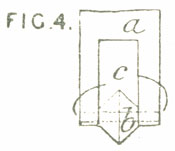 Cutting glass. — A glasscutting instrument consists of a hardened steel wheel b which revolves freely on the pin c and mounted on a handle. The two sides forming the cutting edge meet at a right-angle, or nearly so, and the wheel is ground, after being fixed in position, by allowing one side to lie flat on the "hone" and moving the handle backwards and forwards. The wheel is reversed to grind the other side. The tool is provided with notches for breaking off the glass after being cut.
Cutting glass. — A glasscutting instrument consists of a hardened steel wheel b which revolves freely on the pin c and mounted on a handle. The two sides forming the cutting edge meet at a right-angle, or nearly so, and the wheel is ground, after being fixed in position, by allowing one side to lie flat on the "hone" and moving the handle backwards and forwards. The wheel is reversed to grind the other side. The tool is provided with notches for breaking off the glass after being cut.
 Moulding. — In making moulded glass vessels or other hollow articles, in which holes are required for the insertion of taps, stoppers, or other attachments, such holes are left in the article at the time they are moulded, and an increased thickness a is formed round the holes in the interior of the article. The inner ends of the holes may be closed by a thickness of glass when moulded, which can be readily removed afterwards to complete the hole. The holes may be formed with screw-threads to receive screw attachments. The invention may be applied to glass barrels, filters, lamp and other vases, ink holders with two or more compartments, jugs, tankards, cups, hollow globes for forming ornaments, chandelier and lamp bodies, knife, door, tea-kettle, beer-machine, and other handles, and other hollow glass vessels or fittings. Glass taps, pipes, or stoppers may be formed in a like manner for the insertion of a plug of glass or other material with or without washers.
Moulding. — In making moulded glass vessels or other hollow articles, in which holes are required for the insertion of taps, stoppers, or other attachments, such holes are left in the article at the time they are moulded, and an increased thickness a is formed round the holes in the interior of the article. The inner ends of the holes may be closed by a thickness of glass when moulded, which can be readily removed afterwards to complete the hole. The holes may be formed with screw-threads to receive screw attachments. The invention may be applied to glass barrels, filters, lamp and other vases, ink holders with two or more compartments, jugs, tankards, cups, hollow globes for forming ornaments, chandelier and lamp bodies, knife, door, tea-kettle, beer-machine, and other handles, and other hollow glass vessels or fittings. Glass taps, pipes, or stoppers may be formed in a like manner for the insertion of a plug of glass or other material with or without washers.
